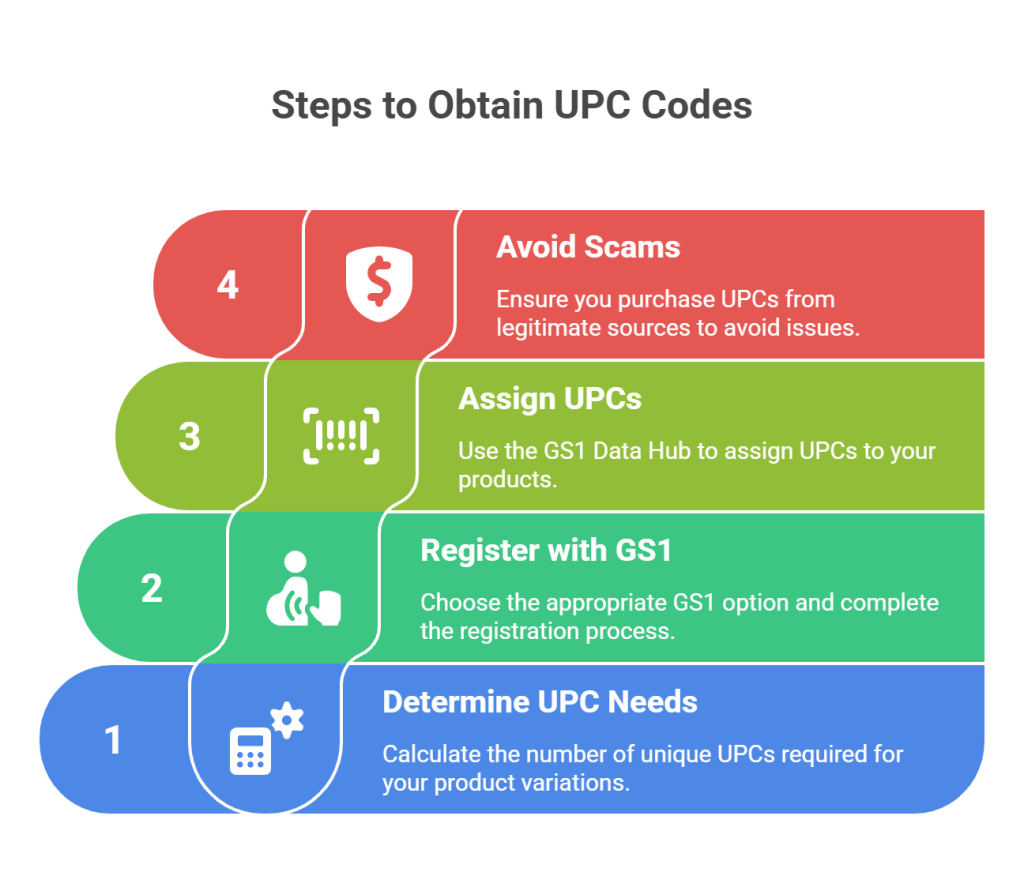Introduction
Did you know that the Universal Product Code (UPC) first appeared on a pack of Wrigley’s chewing gum in 1974?
Since then, UPCs have been used for more than 50 years in all forms of commerce.
Today, these familiar barcodes appear on almost everything we purchase – from egg cartons to sneakers. With the rise in online ecommerce from giants like Walmart and Amazon, having a UPC barcode is now a necessity for bringing your product to market, whether online or in-store. UPCs serve as distinct, universal tags that streamline the retail process in our digital world.
For us as business owners, understanding UPCs isn’t just about compliance – it’s about opportunity. These standardized codes hasten the checkout procedure, maintain up-to-date inventory accounting, and are essential when selling to wholesalers. However, a common mistake many companies make is creating their own UPC numbers, which doesn’t work.
In this guide, we’ll walk you through everything you need to know about Universal Product Codes – from what they are and how to register them properly to implementing them effectively for retail success. Let’s decode the world of UPCs together!
Key Takeaways
- Register only with GS1 or authorized providers– Third-party UPC sellers offer invalid codes that major retailers like Amazon and Walmart will reject, potentially damaging your business.
- Each product variation needs its own unique UPC– Different sizes, colors, or formulations require separate codes, so calculate your total needs before purchasing.
- UPCs streamline operations beyond compliance– They enable accurate inventory tracking, faster checkouts, efficient fulfillment, and are mandatory for major marketplaces.
- Proper barcode placement ensures successful scanning– Position UPCs on smooth surfaces with adequate white space, using black bars on white backgrounds for optimal readability.
- Verify UPCs through official GS1 databases– Use legitimate lookup tools to confirm authenticity and avoid costly inventory mistakes or marketplace suspensions.
What is a UPC (Universal Product Code)?

A Universal Product Code (UPC) is a standardized barcode symbology that functions as a unique product identifier across retail environments worldwide. Appearing as a series of black bars with a 12-digit number beneath, these codes serve as digital fingerprints for products, enabling instant identification when scanned.
Definition and Purpose of UPCs
The UPC consists of a scannable strip of black bars and white spaces positioned above a sequence of 12 numerical digits. First implemented in the early 1970s, UPCs have become an integral part of global commerce, creating a universal language for product identification.
The primary purpose of UPCs is to create standardization across retail platforms. They allow for:
- Accurate inventory tracking – Companies can instantly update stock levels and improve supply chain efficiency by scanning UPCs
- Streamlined checkouts – Cashiers or self-checkout systems can quickly retrieve product information and pricing
- Enhanced recall capabilities – Manufacturers can precisely identify and recall specific product batches before they reach consumers
- Better sales forecasting – Businesses gain insights into product performance, sales velocity, and reorder needs
Importantly, each UPC is product-specific rather than unit-specific. This means all identical items share the same UPC, while variations of the same product (different sizes, colors, or formulations) require unique codes.
How UPCs Work in Retail and Ecommerce
In physical retail environments, UPCs transform the shopping experience through efficient scanning. Rather than manually entering product details, employees simply scan the code to access complete product information in seconds.
For e-commerce operations, UPCs deliver several key benefits:
- Inventory management – UPCs facilitate product tracking across warehouses and fulfillment centers, helping businesses know exactly which products need restocking
- Fulfillment accuracy – Warehouse staff can verify they’re picking and packing the correct items, minimizing errors and improving order accuracy
- Marketplace compliance – Major platforms like Amazon require valid UPCs for inventory control and may reject listings without them
Additionally, UPCs serve as vital links between physical and digital inventory. Companies like Amazon use UPCs to organize inventory and create clear connections between online sales and physical stock, preventing runaway backorders.
Universal Product Code (UPC) vs. GTIN
Although often used interchangeably, UPCs and GTINs have a specific relationship. The Global Trade Item Number (GTIN) refers to the actual identifying number encoded under a barcode, while the UPC is the scannable element.
In essence, a UPC is a specific type of GTIN. The complete relationship works as follows:
- GTIN-12 is the UPC – a 12-digit number primarily used in North America
- GTIN-13 is also called EAN or JAN – a 13-digit number mostly used in Europe and elsewhere
- GTIN-14 is a 14-digit number used for packaging cases
- GTIN-8 is an 8-digit number used for smaller items
One notable distinction: EANs include a 13-digit code that’s almost identical to a 12-digit GTIN, except it has a single zero in front of the GTIN. Furthermore, many retailers now check UPCs against the official GS1 database, making proper registration increasingly important.
Despite being used regionally, both UPCs and EANs are part of GS1’s international standards, meaning both are accepted and readable globally.
Breaking Down the UPC Structure
Every Universal Product Code (UPC) contains a wealth of information encoded within its simple-looking structure. Understanding the anatomy of a UPC helps businesses properly identify their products in the global marketplace.

Manufacturer Prefix
The first six to nine digits of a UPC are known as the “Company Prefix“. This unique identifier is assigned by GS1 (formerly the Uniform Code Council), a non-profit organization that manages the global standards for business communication.
This prefix serves as your company’s signature throughout the supply chain, immediately identifying you as the brand owner. The length of your prefix depends on how many products you need to identify – companies with fewer products receive longer prefixes, while those with extensive product lines get shorter ones.
For instance, small companies needing to identify only 10 product variations typically receive a 10-digit prefix. Consequently, businesses requiring more UPCs will have shorter prefixes, giving them more digits to work with for their product numbers.
Product Number
Following the manufacturer prefix are the product numbers – unique identifiers for individual items within your product line. Unlike the company prefix, these numbers are assigned by each company itself.
Product numbers typically occupy the remaining digits after the manufacturer prefix (before the check digit). These numbers must be unique for each product variation – different sizes, colors, or formulations all require separate product numbers.
Notably, a common mistake many businesses make is creating their own complete UPC numbers. This approach doesn’t work because valid UPCs must contain a GS1-assigned Company Prefix to scan properly at the point of sale.
Check Digit and Its Role
The final digit in a UPC is the check digit – a crucial element for ensuring accuracy. This digit isn’t part of your actual product data but is calculated using a mathematical formula based on the preceding 11 digits.
The check digit functions as a verification mechanism. When a UPC is scanned, the scanner calculates the check digit using the same formula and compares it to the printed check digit. If they match, the scan is confirmed accurate; if not, an error is flagged.
The calculation follows these steps:
- Add the digits in odd-numbered positions (1st, 3rd, 5th, etc.)
- Multiply this sum by 3
- Add the digits in even-numbered positions (2nd, 4th, 6th, etc.)
- Find the result modulo 10 (remainder when divided by 10)
- If the remainder is zero, the check digit is 0; otherwise, subtract the remainder from 10
For example, with UPC “03600029145x” (where x is the check digit):
- Odd-positioned digits: 0+6+0+2+1+5=14
- Multiply by 3: 14×3=42
- Add even-positioned digits: 42+(3+0+0+9+4)=58
- Find modulo 10: 58÷10=5 remainder 8
- Subtract from 10: 10-8=2. Therefore, the check digit is 2.
UPC-A vs. UPC-E Formats
UPC comes in two primary formats: UPC-A and UPC-E. The standard UPC-A is the full 12-digit code most commonly seen on products. It follows the pattern of number system digit, manufacturer code, product code, and check digit.
UPC-E, meanwhile, is a compressed version showing just eight digits. Often called “zero-suppressed UPC,” it compresses a normal 12-digit UPC-A by eliminating the number system digit, trailing zeros in the manufacturer code, and leading zeros in the product code.
This compressed format is specifically designed for smaller packages where space for a full barcode is limited. Despite its compressed nature, a UPC-E can be expanded back into a standard UPC-A 12-digit number when needed.
The main difference between these formats lies in their physical size and digital presentation, yet both contain the same essential information about the manufacturer and product.
How to Get UPC Code for Your Product
Getting your products into retail stores or online marketplaces starts with obtaining legitimate Universal Product Codes (UPCs). The process involves several crucial steps that must be followed precisely to ensure your products can be sold without complications.

Step 1 – Determine How Many UPCs You Need
Initially, you must calculate exactly how many unique UPCs your business requires. Each variation of your product needs its own distinct UPC, including:
- Different sizes (small, medium, large)
- Different colors or patterns
- Different packaging configurations
- Different formulations or features
A practical example: If you manufacture t-shirts in three sizes (small, medium, large), three colors (blue, pink, purple), and three styles, you would need 27 separate UPCs. Additionally, if those same products come in three different packaging options, your requirement jumps to 81 UPCs.
Step 2 – Register with GS1 or An Authorized Provider
Once you’ve determined your UPC needs, you must register with GS1, the official global standards organization that manages UPC assignments. Two primary options exist:
For small inventories: Purchase individual GS1 US GTINs at $30 each with no renewal fees. This option works best for businesses with just a few products.
For growing product lines: License a GS1 Company Prefix starting at $250 annually. This option provides multiple barcodes and enables you to identify locations, create mixed cases, develop coupons, and manage higher packaging levels.
Registration is straightforward through the official GS1 US website (gs1us.org), typically involving three steps: selecting your prefix or GTIN, providing contact information, and completing payment.
Step 3 – Assign UPCs to Your Products
Afterwards, you’ll receive access to GS1 US Data Hub, where you can assign specific product numbers to each item. The typical process involves:
- License your Company Prefix from GS1
- Assign product numbers to each unique product
- Generate a check digit using the GS1 calculator
- Combine these elements to create your 12-digit UPC
Avoiding third-party UPC scams
Presently, numerous unauthorized websites offer UPCs at discounted rates, sometimes as low as $5. These bargains are typically problematic. Major retailers like Amazon and Walmart generally reject these unauthorized codes.
To protect yourself:
- Purchase UPCs directly from GS1 US (gs1us.org)
- Avoid providers claiming to sell “cheap” or “discount” UPCs
- Never create your own UPCs using random formulas
- If you’re not the brand owner, contact them directly about UPC assignments
Remember, legitimate retailers increasingly verify UPCs against the official GS1 database, making proper registration increasingly important for your long-term retail success.
Using UPCs in Retail and Online Stores
Once you’ve obtained your UPC codes, proper implementation becomes the key to retail success. The correct placement and usage of Universal Product Codes significantly impacts your product’s journey from warehouse to consumer.

1. Placing UPC Barcodes on Packaging
Proper placement of UPC barcodes on product packaging is essential for successful scanning. The ideal location is typically in the lower right-hand section of the back of the package, printed on a smooth surface to enable clean scanning. Important to realize, barcodes need adequate white space surrounding them—avoid placing them near edges or on curved surfaces whenever possible.
For optimal scanning, use black bars on a white background. Red bars should be avoided as scanning lasers use red light, making red bars essentially invisible to scanners. Each package type requires specific placement considerations—cylindrical items, flexible packaging, and small products all have unique requirements to ensure proper scanning.
2. Selling on Amazon and Other Marketplaces
Major online retailers, including Amazon, Walmart, and Google Shopping, require valid UPCs for product listings. Undoubtedly, these marketplaces use UPCs to avoid duplicate listings and ensure accurate product identification across their platforms.
Each product variant (size, color, model) needs its own unique UPC. Accordingly, a dress available in four sizes would require four distinct UPCs, even though they would appear as variations on the same listing page.
3. Inventory and Fulfillment Benefits
UPCs significantly enhance inventory management by enabling accurate product tracking throughout the supply chain. Moreover, they streamline warehouse operations, allowing for quick identification of products during picking and packing processes.
For businesses working with third-party logistics (3PL) partners, UPCs improve order accuracy and processing speed. Proper UPC implementation enables efficient inventory tracking in fulfillment centers and faster shipping to customers.
4. Universal Product Code Amazon Requirements
Amazon has implemented strict verification processes for UPCs, cross-checking them against the GS1 database to verify authenticity. Henceforth, all UPCs must be GS1-registered and verifiable through their database, with the UPC registered to your brand or company.
For Amazon FBA sellers, items require either the original UPC barcode or an Amazon-specific FNSKU label. Using invalid or duplicate UPCs can result in serious consequences, including listing suppression or account suspension—making proper UPC registration an essential investment.
Looking Up and Verifying UPCs
Verifying the legitimacy of UPCs is just as crucial as obtaining them. Without proper verification, businesses risk inventory mishaps and marketplace rejections that can damage their bottom line.
Universal Product Code Lookup Tools
The GS1 Database stands as the authoritative source for UPC verification, functioning as a single source of truth for checking GS1 identification numbers. This official registry allows businesses to verify which company licensed a specific GS1 Company Prefix and access basic product information. Other popular lookup tools include UPCitemdb and Barcode Lookup, which provide quick access to product details by simply entering the barcode number.
How to Perform a Universal Product Code Search
Searching for UPC information typically follows one of several methods:
- Enter the UPC number directly into online databases
- Use mobile apps that scan barcodes via smartphone cameras
- Employ dedicated barcode scanner devices for business operations
For Amazon products specifically, you can find UPCs by searching product details and using ASIN-to-UPC converter tools.
Verifying UPCs for Accuracy and Authenticity
Beyond basic lookup, validating UPCs involves two primary verification methods:
First, calculate the check digit using the Mod-10 algorithm—add digits in odd positions, multiply by 3, add even-positioned digits, and verify the result ends in zero.
Secondly, use Verified by GS1, which confirms whether a code follows proper structure and is legitimately registered to a specific company. This service answers critical questions about number structure, licensing, and ownership.
Conclusion
Universal Product Codes have transformed from simple barcodes on a pack of gum to essential business tools for retail success. Throughout this guide, we’ve explored how UPCs serve as the backbone of modern commerce, connecting physical products with digital systems seamlessly. Therefore, understanding and properly implementing UPCs remains crucial for any business looking to thrive in today’s retail landscape.
Remember, legitimate UPCs must come from GS1 or authorized providers – anything else simply won’t work. Additionally, each product variation requires its unique code, making it essential to calculate your needs accurately before registration. Many businesses, unfortunately, fall into the trap of purchasing unauthorized codes or creating their own, leading to rejected listings and inventory problems.
The benefits of properly implemented UPCs extend far beyond basic identification. These standardized codes streamline checkout processes, maintain accurate inventory records, and enable effective order fulfillment. Consequently, your business operations become more efficient while meeting the requirements of major retailers and marketplaces.
Most importantly, UPCs create a universal language that connects your products to the global supply chain. This standardization allows your items to move effortlessly between warehouses, retail shelves, and customer doorsteps. Though the initial investment might seem significant, particularly for businesses with numerous product variations, the long-term value proves undeniable.
We encourage you to view UPCs not merely as compliance requirements but as strategic business tools. The right approach to UPC implementation will open doors to retail partnerships, streamline your operations, and ultimately contribute to your company’s growth. Start with proper GS1 registration, carefully assign codes to each product, and watch your retail presence expand with confidence.
Commport Datapool Solutions
Download: GDSN Buyers Guide
Empower your business with global data synchronization; download our GDSN Buyer's Guide today and take the first step towards streamlined, accurate, and compliant product data management.
Frequently Asked Questions
To get legitimate UPC codes, register with GS1 (www.gs1us.org in the US). Avoid third-party sellers offering cheap codes, as these are often invalid and rejected by major retailers. GS1 offers options for individual codes or company prefixes based on your needs.
A UPC barcode typically contains a 12-digit number. This includes a manufacturer prefix (assigned by GS1), a product number (assigned by the company), and a check digit for accuracy verification. The barcode visually represents this information for easy scanning.
For optimal scanning, place UPC barcodes on a smooth surface in the lower right-hand corner of the package’s back. Use black bars on a white background and ensure adequate white space around the barcode. Avoid placing barcodes on edges or curved surfaces.
While major retailers and online marketplaces typically require UPC codes, some smaller boutique stores may be able to work with products that don’t have UPCs. However, having legitimate UPC codes can streamline operations and open up more selling opportunities as your business grows.
To verify a UPC code’s authenticity, use the GS1 database, which is the authoritative source for UPC verification. You can also use online tools like UPCitemdb or Barcode Lookup. For Amazon products, ASIN-to-UPC converter tools are available. Always ensure your UPCs are registered with GS1 to avoid marketplace rejections.





